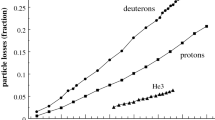Abstract
We present calculations of deuteron elastic and nonelastic breakup cross sections and angular distributions at deuteron energies below 100 MeV obtained using the post-form DWBA approximation. The elastic breakup cross section was extensively studied in the past. Very few calculations of nonelastic breakup have been performed, however. We compare two forms of the elastic DWBA breakup amplitude but conclude that neither provides a correct description of the inclusive proton emission cross section.
Similar content being viewed by others
References
Betak, E. et al: Technical Reports Series 473, Nuclear Data for the Production of Therapeutic Radionuclides, IAEA, Vienna, Austria, (2011), ISBN 978-92-0-115010-3.
Escher J.E., Burke J.T., Dietrich F.S., Scielzo N.D., Thompson I.J., Younes W.: Compound-nuclear reaction cross sections from surrogate reactions. Rev. Mod. Phys. 84, 353 (2012)
Baur G., Trautmann D.: The break-up of the deuteron and stripping to unbound states. Phys. Rep. 25, 293 (1976)
Baur G., Rösel F., Trautmann D., Shyam R.: Fragmentation processes in nuclear reactions. Phys. Rep. 111, 333 (1984)
Kasano A., Ichimura M.: A new formalism of inclusive breakup reactions and validity of the surface approximation. Phys. Lett. B 115, 81 (1982)
Austern N., Iseri Y., Kamimura M., Kawai M., Rawitscher G., Yahiro M.: Continuum-discretized coupled-channels calculations for three-body models of deuteron-nucleus reactions. Phys. Rep. 154, 125 (1987)
Bonaccorso A., Brink D.M.: Nucleon transfer to continuum state. Phys. Rev. C 38, 1776 (1988)
Bonaccorso A., Brink D.M.: Nucleon transfer to continuum state. Phys. Rev. C 43, 299 (1991)
Bonaccorso A., Brink D.M.: Stripping to the continuum of Pb 208. Phys. Rev. C 44, 1559 (1991)
Bonaccorso A., Lhenry I., Suomijärvi T.: Inclusive spectra of stripping reactions induced by heavy ions. Phys. Rev. C 49, 329 (1994)
Hashimoto S., Yahiro M., Ogata K., Minomo K., Chiba S.: Effective radii of deuteron-induced reactions. Phys. Rev. C 83, 054617 (2011)
Yahiro M., Ogata K., Matsumoto T., Minomo K.: The continuum discretized coupled-channels method and its applications. Prog. Theor. Exp. Phys. 2012, 01A206 (2012)
Lei J., Moro A.M.: Revisiting closed-form formulae for inclusive breakup: application to deuteron and 6Li induced reactions. Phys. Rev. C 92, 044616 (2015)
Lei J., Moro A.M.: Numerical assessment of post-prior equivalence for inclusive breakup reactions. Phys. Rev. C 92, 061602(R) (2015)
Potel G., Nunes F.M., Thompson I.J.: Establishing a theory for deuteron-induced surrogate reactions. Phys. Rev. C 92, 034611 (2015)
Carlson, B.V., Capote, R., Sin, M.: Elastic and nonelastic breakup of deuterons with energy below 100 MeV. In: Proceedings-2015-001, 163 (2015), (https://cds.cern.ch/record/2114737).
Buttle P.J.A., Goldfarb L.J.B.: Finite range effects in deuteron stripping processes. Proc. Phys. Soc. 83, 701 (1964)
Sommerfeld A.: Uber die Beugung und Bremsung der Elektronen. Ann. Physik (Leipzig) 11, 257 (1931)
Landau L., Lifschitz E.: On the theory of energy transfer during collisions III. JETP 18, 750 (1948)
Nordsieck A.: Reduction of an integral in the theory of bremsstrahlung. Phys. Rev. 93, 785 (1954)
Koning A.J., Delaroche J.P.: Local and global nucleon optical models from 1 keVto 200 MeV. Nucl. Phys. A 713, 231 (2003)
Han Y., Shi Y., Shen Q.: Deuteron global optical model potential for energies up tp 200 MeV. Phys. Rev. C 74, 044615 (2006)
An H., Cai C.: Global deuteron optical model potential for the energy range up to 183 MeV. Phys. Rev. C 73, 054605 (2006)
Vincent C.M., Fortune H.T.: New method for distorted-wave analysis of stripping to unbound states. Phys. Rev. C 2, 782 (1970)
Matsuoka N., Kondo M., Shimizu A., Saito T., Nagamachi S., Sakaguchi H., Goto A., Ohtani F.: Deuteron breakup in the fields of nuclei at 56 MeV. Nucl. Phys. A 345, 1 (1980)
Pampus J., Bisplinghoff J., Ernst J., Mayer-Kuckuk T., Rama Rao J., Baur G., Rösel F., Trautmann D.: Inclusive spectra from deuteron break-up: Theory and experiment. Nucl. Phys. A 311, 141 (1978)
Author information
Authors and Affiliations
Corresponding author
Rights and permissions
About this article
Cite this article
Carlson, B.V., Capote, R. & Sin, M. Inclusive Proton Emission Spectra from Deuteron Breakup Reactions. Few-Body Syst 57, 307–314 (2016). https://doi.org/10.1007/s00601-016-1054-8
Received:
Accepted:
Published:
Issue Date:
DOI: https://doi.org/10.1007/s00601-016-1054-8




